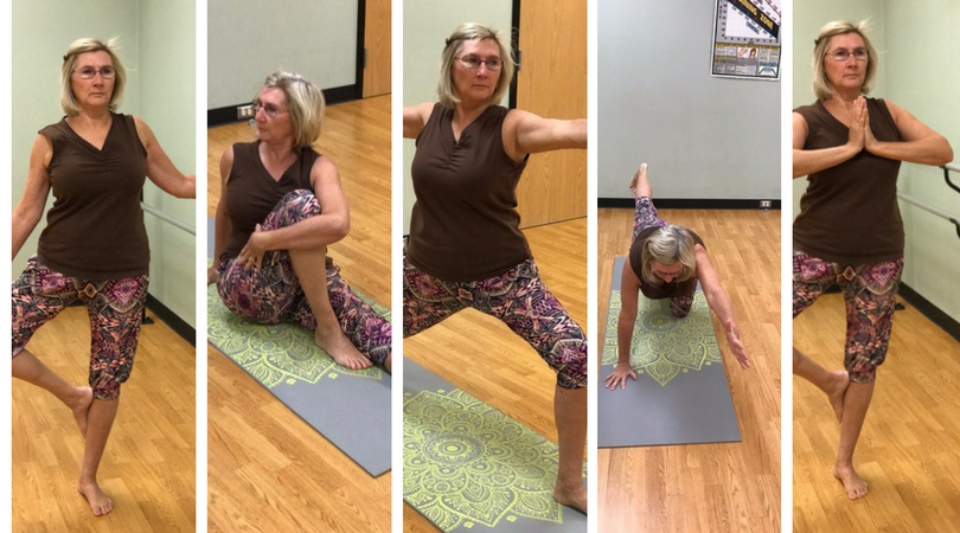The Basics of Yoga for Seniors

Think yoga is only for the young and beachy? Think again! Practicing yoga is great exercise at any age, but seniors especially benefit from moves that bring improved posture, sleep quality and pain relief. You don’t have to be a yoga guru to get started – basic poses provide a surprising amount of payoff to your overall health.
Benefits of yoga
"Yoga involves breath work, postures and meditation," says Vicki Bryant, a yoga instructor at INTEGRIS YMCA Healthy Living Center. "I try to incorporate all three in my classes." Each core yoga element leads to improved flexibility, strength and mobility – all crucial health factors for seniors. The regular stretching involved in yoga can provide pain relief and reduce muscle tension.
"As we age, our spines become stiff, which causes pain," Bryant says. "Keeping the spine supple by practicing forward bends and back bends like the Cobra Pose can help alleviate back problems."
Yoga can also be an ideal stress reliever and sleep aid. Many yoga trainers believe regular yoga leads to increased relaxation and improved sleep. Relaxation and breathing can also benefit you by lowering blood pressure and improving mood. "Meditation helps with depression and can help us feel more energetic," says Bryant.
Five basic yoga moves
These basic moves don’t require equipment although a yoga mat is recommended for comfort. Remember to breathe and move slowly. Modify moves to your ability and comfort. Yoga is about patience, meditation and focus.
1. Tree Pose
Balance is key for Tree Pose. If you’re concerned about your ability to balance, use a wall or bar to steady yourself. If falling is a concern for you, perform this and other standing poses with another person in the room. To perform Tree Pose:
- Stand tall with your arms at your sides.
- Your weight should be distributed evenly on both feet.
- Shift your weight to one foot.
- Slightly bend your knee on your weighted side.
- Reach down to pull your unweighted foot and ankle to set just below your bent knee. You may modify this pose to set your foot lower or higher.
- If balanced, try pressing your hands together at your chest in a palm-flat prayer position.
2. Seated Side Twist
A side twist will help stretch your lower back and torso. To perform a Seated Side Twist:
- Sit on a flat surface with your back straight and shoulders even.
- Bring one leg toward your body.
- Keep the drawn-in leg’s foot flat on the mat.
- Bring your opposite arm over the drawn-in leg and pull both to your body as much as you’re able while remaining comfortable.
- Place your other arm and hand slightly behind you to keep balance.
- While keeping your back and shoulders straight, gently rotate your torso outward on the same side of your supporting arm.
3. Warrior Pose
Warrior Pose is about power. To perform a Warrior Pose:
- Begin by standing with your feet firmly aligned, hip-distance apart.
- Rest your arms at your side.
- Step your legs apart about five feet. Modify to a smaller distance if needed.
- Rotate your right foot out so that your toes are pointing toward the top of the mat.
- Turn your left foot inward slightly. Your front heel should be aligned with the arch of your other foot.
- Your pelvis should turn toward the top of the mat.
- Slightly bend your right knee over your ankles, keeping your shin perpendicular to the floor.
- Raise your arms parallel with your body and hold.
4. Opposite Arm & Leg Lift
Opposite arm and leg lifts will make you feel long and lean. To perform Opposite Arm & Leg Lift:
- Set yourself on all fours.
- Keep your hands under your shoulder and your knees aligned under your hips.
- Your head and neck should be aligned with your back.
- Simultaneously raise your back left leg and your right arm parallel to the floor.
- Hold the position and breathe.
- Gently lower both limbs back down and repeat with the opposite arm and leg.
5. Cobra Pose
The Cobra Pose is great for back pain relief. To perform the Cobra Pose:
- Lie face down on your mat with your legs behind you.
- Bring your hands under your shoulders, pointing your fingers toward the top of the mat.
- Keep your elbows close to your body.
- Press your feet down with your toes spread.
- Your rib cage should be pressed slightly the floor.
- Draw your shoulders back.
- Be careful to keep your neck long and strong and your gaze down toward the mat.
- Slowly straighten your arms and lift your chest from the floor.
- Your lower half should be pressed into the ground.
- Only straighten your arms as much as your body will let you. Don’t force any stretch.
- Hold the pose and breathe.
If you have preexisting medical conditions or injuries that may affect your ability to perform yoga, check with your doctor or a certified yoga instructor before you begin a regular yoga regiment.
If you don’t want to go practice yoga alone, check out class schedule at YMCA Healthy Living Center - INTEGRIS to participate in a yoga class.

